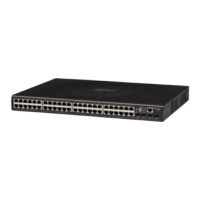Chapter 18
| VLAN Commands
Configuring VXLAN Tunneling
– 498 –
In addition to forwarding the packet to the destination VM, the remote VTEP learns
the mapping from inner source MAC to outer source IP address. It stores this
mapping in the bridge lookup table so that when the destination VM sends a
response packet, there is no need for “unknown destination” flooding of the
response packet.
Determining the MAC address of a destination VM prior to transmission by the
source VM is performed as with non-VXLAN environments. Broadcast frames are
used but are encapsulated within a multicast packet.
Broadcast Communication and Mapping to Multicast
Consider the VM on the source host attempting to communicate with the
destination VM using IP as it normally would. Assuming that they are both on the
same subnet, the VM sends out an ARP broadcast frame. In this non-VXLAN
environment, this frame would be sent out using MAC broadcast across all switches
carrying that VLAN.
With VXLAN, a header including the VXLAN VNI is inserted at the beginning of the
packet along with the outer IP header and outer UDP header. However, this
broadcast packet is sent out to the IP multicast group on which that VXLAN overlay
network is realized.
To effect this, we need to have a mapping between the VXLAN VNI and the IP
multicast group that it will use. (This information must be configured using the
vxlan flood command.) Using this mapping, the VTEP can provide IGMP
membership reports to the upstream switch/router to join/leave the VXLAN-related
IP multicast groups as needed. This will enable pruning of the leaf nodes for specific
multicast traffic addresses based on whether a member is available on this host
using the specific multicast address. In addition, use of multicast routing protocols
like Protocol Independent Multicast - Sparse Mode (PIM-SM) will provide efficient
multicast trees within the Layer 3 network
The destination VM sends a standard ARP response using IP unicast. This frame is
encapsulated and sent back to the VTEP connecting to the originating VM using IP
unicast VXLAN encapsulation. This is possible since the mapping of the ARP
response’s destination MAC to the VXLAN tunnel end point IP was learned earlier
through the ARP request.
Note that multicast frames and “unknown MAC destination” frames are also sent
using the multicast tree, similar to the broadcast frames.
Table 97: VxLAN Tunneling Commands
Command Function Mode
vxlan udp-dst-port Configures the VXLAN UDP destination port GC
vxlan flood Configures remote VXLAN tunnel endpoint (VTEP) when
received packet fails bridge table lookup
GC
vxlan vlan vni Associates a VLAN ID with a virtual network identifier (VNI) GC
debug vxlan Enables specified debug flag PE
show mac-address-table Shows MAC address entries for VXLAN VNI PE

